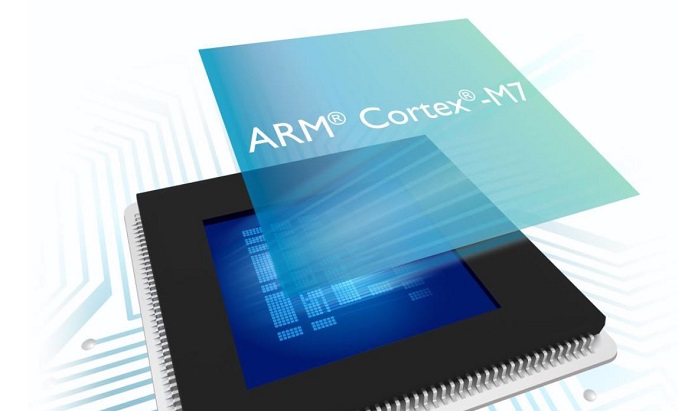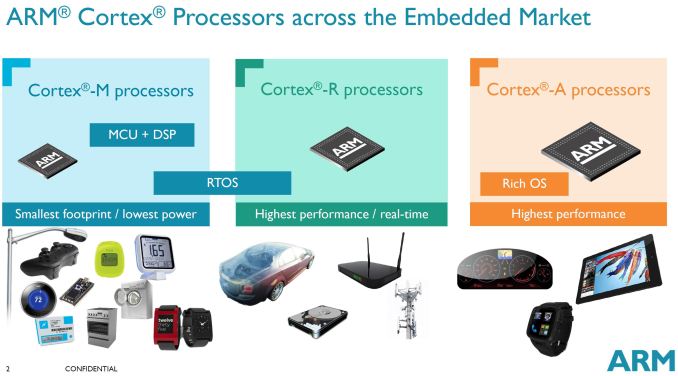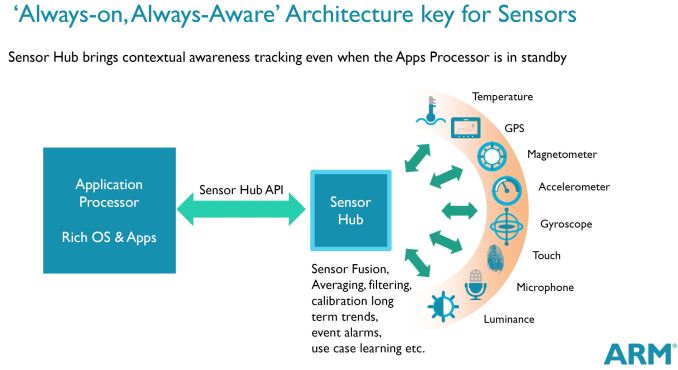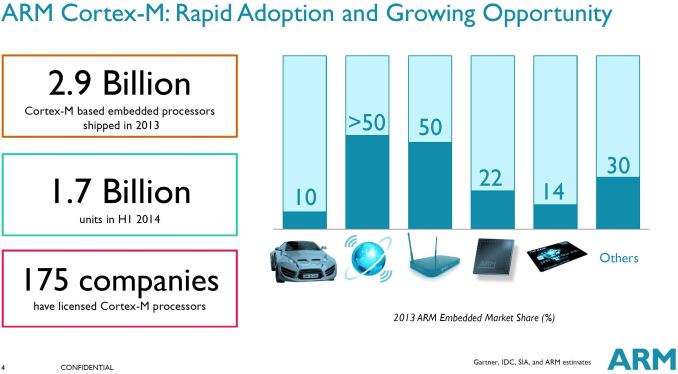Cortex-M7 Launches: Embedded, IoT and Wearables
by Stephen Barrett on September 23, 2014 7:01 PM EST
Introduction
Last week, I had the distinct pleasure of visiting ARM’s Austin Texas campus for a meeting with Vice President of CPU Product Marketing Nandan Nayampally. The topic of discussion: ARM’s next Cortex-M processor, codename Pelican, is officially launching today as the Cortex-M7. Thankfully, unlike the A series CPU cores mobile device enthusiasts have grown to love, M and R series cores are typically announced at the same time as retail availability from ARM’s customers. ARM has therefore been working with lead semiconductor partners for some time, and their fully integrated products should have similar launch announcements soon.
If you are not familiar with the M and R series processors from ARM, I don’t blame you. These microcontroller processors don’t receive quite the coverage as A series application processors like the A7, A9, A15, A53 and A57 do. Considering my own heritage learning about PC technology, this is understandable. I always wanted to learn about the latest processors from AMD and Intel as these most directly related to my productivity and entertainment. However, if the smartphone wave was any indication, the next decade of productivity and entertainment might come from processors we don’t expect or even know about.
Fundamentally, the M series processors are considered microcontrollers and not application processors, mainly because they lack a memory management unit (MMU). An MMU’s primary role is to sit between the processor and memory, intercepting all memory references and performing translation between virtual addresses and physical addresses. General purpose operating systems such as Linux (Android), Windows, OSX, and iOS require an MMU to function. That means M series processors, like all microcontrollers (MCUs), will never be tasked with running general purpose operating systems.
MCU proliferation is actually already happening today. Nandan mentioned that a device containing a single R or A series processor might also contain dozens of Cortex-M processors performing a variety of tasks that make your life better. Nandan couldn’t mention any specific implementations, as he deferred to ARM's customer’s for that, but everything from smart thermostats, simple smart watches like the Pebble, and IC power management units are implemented with low power microcontrollers.
Even features we love on our high powered smartphones such as Microsoft’s Lumia Glance Screen and SensorCore, Motorola’s Moto Voice and Moto Display, and the iPhone’s Motion Coprocessor cannot be directly attributed to bigger faster application processors but rather come from MCUs, and arguably they have just as big an impact on our lives as a lower Sunspider score.
Looking at ARM’s track record in the past five years, one can easily correlate their success with the smartphone craze started with the original iPhone containing an ARM11 processor. From there, the 3GS upgraded to a Cortex-A8, 4S used the Cortex-A9, and Google attacked the same market with Android supporting the ARM11 and subsequent ARM cores as well. While ARM’s meteoric rise might have started with the ARM11, it was years of prior work that provided a solid foundation for partners and customers. In fact there were 11 cores released prior to the ARM11 (fancy that), including six revisions to their instruction set.
ARM has been investing in the Cortex-M line since 2004, when they first released the Cortex-M3. For a decade, ARM has been combating 8-bit and 16-bit microcontrollers with their 32-bit M series. With the release of the M7, ARM feels they have a very complete microcontroller lineup and have effectively “crossed the chasm” into the mainstream. The competition continues today, but with eight billion (yes, with a b) processors shipped to date containing at least one Cortex-M core, the M series is higher volume than all other ARM cores combined. In the first half of this year alone, ARM’s partners have shipped 1.7 billion Cortex-M units, where a unit is defined as a chip containing at least one Cortex-M processor.
Responding to market demand for powerful voice, sensor, display, and control offloading, ARM brings a higher performance, feature rich core to the Cortex-M family with the M7.













43 Comments
View All Comments
Guspaz - Tuesday, September 23, 2014 - link
"General purpose operating systems such as Linux (Android), Windows, OSX, and iOS require an MMU to function. That means M series processors, like all microcontrollers (MCUs), will never be tasked with running general purpose operating systems."This is incorrect: Linux runs on the Cortex M and other platforms that lack an MMU via uClinux. There are some differences, yes, but for the most part it's transparent to the developer, and most software runs unmodified.
extide - Tuesday, September 23, 2014 - link
This is true, but there are some pretty big limitations when using uClinux. I wouldn't suggest it unless you really really need it, heh.HardwareDufus - Tuesday, September 23, 2014 - link
Like the Cortex-M3 & M4, it is a 32-bit ARMv7-M core processor. I is said to use a six-stage superscalar pipeline.The ARM press release says that it will have highly flexible system and memory interfaces. Looking forward to seeing more details on that... (though of course it will lack a MMU).
It launches manufactured on a 40nm process and runs up to 400Mhz.
However it will move to a 28nm process in the near future, where performance is expected to double (so one can assume a near doubling of clock speed as well).
Atmel is already said to have a license. Will be interesting to see if the Arduino folks pick this processor up for a new Arduino board. Arduino has picked up the Cortex-0+ for the new Arduino ZERO and uses the Cortex-M3 for the Arduino DUE. But they've yet to use the Cortex-M4. Their latest board, the Arduino TRE uses a Texas Instruments Sitari chip which is a Cortex A series processor. So who knows what direction they are moving in.
Texas Instruments licenses the Cortex-M processors, but I haven't heard of a license for this new processor. I just picked up a nice development board that uses the Cortex-M4 from TI.
HardwareDufus - Tuesday, September 23, 2014 - link
Yes, I over used the phrase 'picked up' and cannot edit it. Feel free to substitute chose, selected, employed, used, etc...xenol - Wednesday, September 24, 2014 - link
Speaking from someone who's used MCUs and the M3/M4 series micro-controllers in development (professionally and hobby), I don't really see a point in using a general purpose OS on a small footprint. Something like this should be doing one thing and doing it very well.There are plenty of RTOSes out there that take up a very tiny footprint that will do memory management and "thread management" for you if you need it. Heck all of my projects have gotten away with doing amazing things without needing a heap (i.e., calling malloc).
The biggest thing I don't like about uCLinux is it requires external RAM. A lot of development boards don't have them.
akdj - Sunday, September 28, 2014 - link
Im curious as to which RTOS, micro controller or any other 'hobby or professional' use case that rivals this M7? It's footprint, efficiency, capabilities and phenomenal 'future' opportunities this motion sensor will provide. You're using vacuum tubes. As are all wearables to date. Those utiliIng this new ARM architecture will be moving directly to SolidState. Overnight. It's THAT HUGE!Best to 're-think' your tools and options, as using a micro-controller in your new project slated for mid 2015 release will be chewed up and spat to the floor by anyone using a 'currently available' M7. Difference between a typewriter and computer with Word Prodessor, with today's capabilities!
J
isa - Tuesday, September 23, 2014 - link
I can't apologize enough for my profound ignorance and stupidity, but what exactly were the 2 similar IoT anouncements on Anandtech in the last 2 days as referenced in the article? I can only find the Mediatek announcement. In the future, links to references would help stupid people like me.extide - Tuesday, September 23, 2014 - link
Mediatek, and this oneloftie - Tuesday, September 23, 2014 - link
If the embargo on the slides are correct, you published an hour early.Stephen Barrett - Tuesday, September 23, 2014 - link
Yeah the CMS failed me on daylight savings. Hopefully we will be forgiven ;-)